How to install and connect an outlet with grounding: learn to ground the outlet
The use of ground outlets ensures the safety of households when using electrical appliances. But home masters are in no hurry to update the wiring, considering the process of installing grounding outlets difficult. Although the standard workflow is quite simple.
We will help you sort this out. Before connecting the outlet with grounding, it is necessary to study its design features and find out the type of wiring in the house. The information in the article is supplemented by visual photo and video instructions for a better understanding of the electrical installation process.
The content of the article:
Why do you need grounding
The instructions for any electrical appliance clearly state that it is forbidden to use it without grounding. The main purpose of grounding is to ensure the stability of complex household appliances and to protect against electric shock.
According to the PUE p. 1.7.6 grounding is a deliberate connection of one of the elements of the electrical installation with the ground loop. It is being built with the aim of diverting the currents of striking and non-striking values along the grounding protective conductor to the ground.
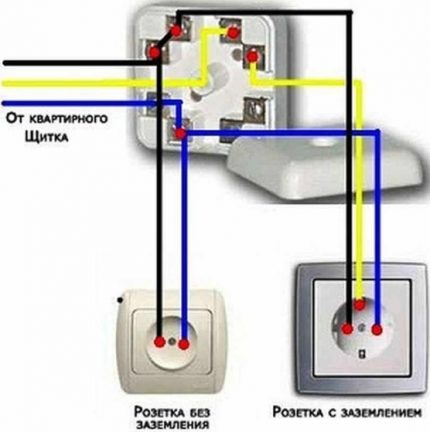
In an outdated system, the “neutral” partially performed the function of grounding. Zero was connected to the metal case of the device, and in case of overload, it took over.
The calculation was that when the load is exceeded, the current will flow through one of the phases, as a result of which there will be a circuit and, as a result, a disconnection of the network section with an automatic or fuse.
This decision simplified the electrical installation, but carried the threat of electric shock.
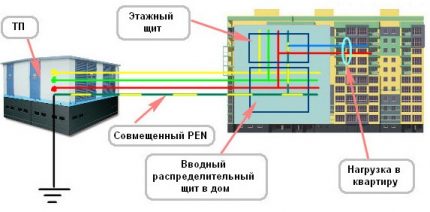
It is unacceptable to connect devices without grounding, the case of which is made of metal. For example: slow cooker, microwave or electric stove. After all, with a short circuit, thinning or partial destruction of the insulation of the wires on the case, a breakdown of current can occur.
In the event of a voltage contact with the conductive element, the protective conductor will lead it further to the ground.
Equally dangerous is the use of devices without grounding that come into contact with water during operation, such as a dishwasher or boiler.
The type and design of the grounding contact depends on the model. In the outlets of American brands, it is presented in the form of holes with side slots. For French counterparts - this is an additional third pin.
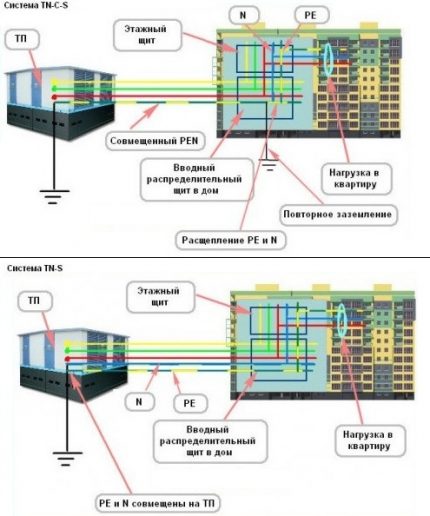
But most often on sale you can find the German type of grounding outlets. They are equipped with bulging metal parts on the sides.
The design of the electrical outlet with grounding assumes the presence of three contacts: “phase”, “zero” and “grounding”. At the moment of switching on, the ground terminals touch in the first fractions of a second, and after them the “phase” and “0” contacts are connected. This sequence guarantees complete protection.
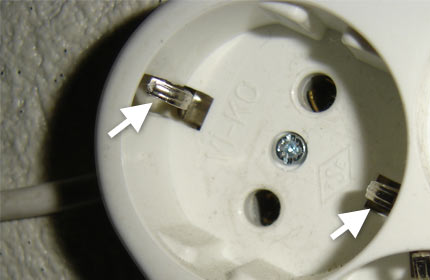
Criteria for choosing the right outlet
When choosing a power outlet with grounding, it is worthwhile to focus on products of manufacturers that are well established in the electrical market.
You can safely trust these manufacturers:Schneider electric, Legrand, Viko, Bticino. From budget, but at the same time not inferior in quality options, it is worth considering products: Anam, Lezard, Makel, Wessen, Dkc.
By purchasing accessories from little-known manufacturers, it is easy to get into trouble when the actual value of the rated current does not correspond to the declared one.

Based on operating conditions, products with a certain degree of protection. So, for installation in kitchens and bathrooms, connection points must have a protection level of at least IP44. The first digit of the IP marking in accordance with international standards indicates protection against dust, the second - from moisture.
Sockets with grounding on the market are presented in a wide range.
On sale you can meet:
- Models with mechanical protection. They are equipped with curtains that cover the nests and protect against direct contact contacts.
- Current leakage protection products. As soon as a foreign object enters the plug holes, the residual current device trips - the point turns off. Such models are often chosen for home improvement, where there are small children.
- Overcurrent Protection Devices, including from short circuit. The products are equipped with a built-in fuse, which, when a short circuit occurs, simply blows out.
- Surge Protected Models. Devices equipped with a built-in switch automatically turn off when exceeding the permissible network values.
- For connecting devices whose power exceeds 4kW. Products, most often of overhead execution, are equipped with a special network plug and are designed for a current of 20-25A.
To connect indoors, it is worth choosing "internal" outlets. They are mounted in specially made niches in the wall.

Detailed information on choosing a moisture-proof outlet for the bathroom is presented in this article.
Recommended rated breaking current for household devices varies between 30-100 milliamps. Models of domestic brands are designed for 6.3 and 10A, and imported ones for 10 and 16A.
When choosing products, pay attention to the size of the inlets for the plug and the distance between them. European models have slightly larger diameters and spacing. To avoid mistakes, choose universal models that come with connectors for different types of plugs.
Definition of wiring type
Installation of an outlet with grounding is carried out in those houses where three-wire wiring is laid. In dwellings with wiring that includes only two cores, it makes no sense to mount such a grounding outlet, since it will not fulfill the task assigned to it.
Therefore, the first thing to do is to determine what type of wiring in the apartment. If the wiring in the house is outdated two-wire, it will have to be replaced with a three-wire analog. Modern three-wire wiring in all respects meets all safety standards.
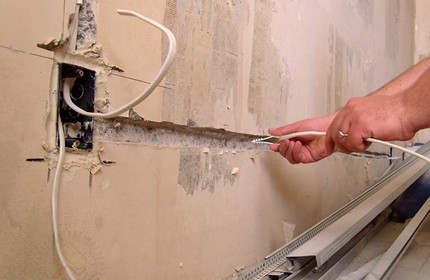
You can find out if there is a grounding bar in the electrical panel at the electrician serving your porch or house. The type of wiring is determined by the number of wires. If a two-wire cable is connected to the connection point, then only “phase” and “neutral” are available.
If the outlet line is laid from the switchboard with a two-wire cable, it is only necessary to bring a third grounding wire from the switchboard to each point. But this procedure can be performed only on condition that the shield is equipped with a grounding bus.
Clause 1.7.127 of the current PUE clearly states that the ground conductor must be made of insulated copper wire with a cross section of at least 2.5 square mm.
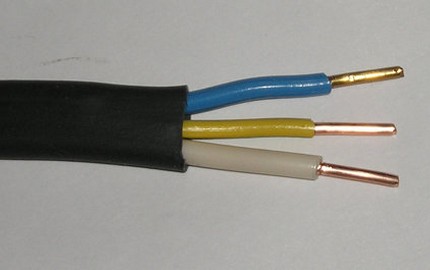
Lay cable with a cross section of 1.5 mm2 from the junction box to the outlet is not appropriate. Indeed, in this case it is impossible to “power up” a powerful device from it. For a single-phase network, it is better to take a section with a margin of 2.5 mm2.
For the organization of electrical wiring in apartments and private homes choose VVG marking cable, for wooden buildings and fire hazardous premises - VVGng.
The main requirement for a protective wire is that its circuit should not contain disconnecting devices. Therefore, it is mounted in addition to any fuses, automatic machines and knife switches.
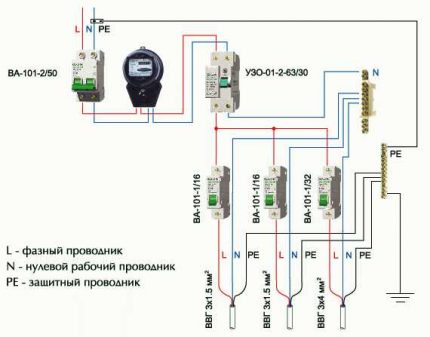
Serial grounding is fraught with the fact that in the event of an emergency, electromagnetic incompatibility may occur. Connected electrical installations will create interference that can lead to undesirable consequences in which the protective circuit does not cope with the task assigned to it.
Installing an invoice option: step-by-step instruction
To begin with, we will analyze the process of connecting an overhead outlet to a cable hidden in the baseboard.
After completing the preparatory steps, we can safely proceed to connect the outlet mechanism to the grounding wiring.
Socket Outlet Technology
Connecting a ground outlet does not involve any complicated manipulations. Anyone who owns only the basic skills of electrical work will be able to set the task.
Preparation of necessary materials
In addition to the outlet itself, it is also necessary to purchase a socket in advance for installing the “core”. The socket for the future connection point is selected based on the type of building materials that you will have to work with.
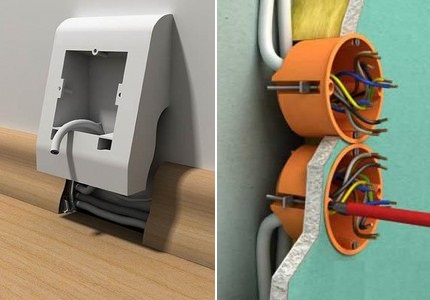
The main difference between the models created for installation in plasterboard walls and their counterparts for installation in brick and concrete surfaces is the presence of spacers.
The fixation of standard podrozetniki in the cavity of the concrete wall is carried out by applying a gypsum or construction alabaster mortar into the prepared hole.
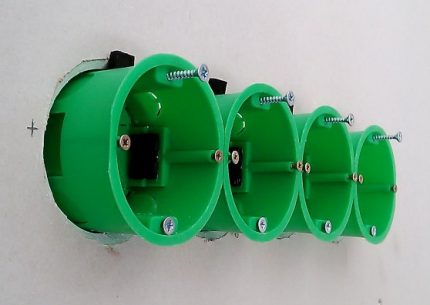
Installation and connection of the grounding socket cannot be performed without a set of tools.
For installation you will need:
- tester screwdriver or multimeter;
- hammer drill equipped with a crown;
- side cutter or cross knife;
- chisel.
To install the socket in the wall, a hole is drilled using a D70 mm crown. The space under the "glass" is cleared of the remnants of building material.
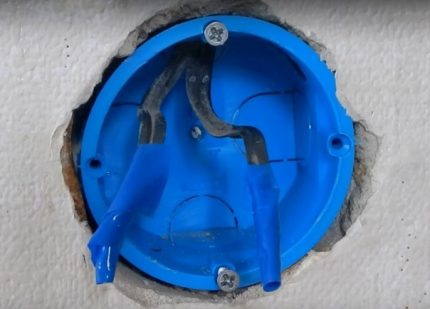
After the socket has been installed, proceed to the wiring.
The step-by-step technology for mounting a wall socket in walls made of drywall and concrete is described in this article.
Identification of wires
Before you install and ground the outlet, first turn off the power on the electrical panel. The task of the master is to relieve voltage from the junction box supplying the line with a socket to be replaced.
The wires laid from the switchboard in an open or closed way lead into the cavity of the socket. Using an electric tester, it is determined where “phase” and where “0”.
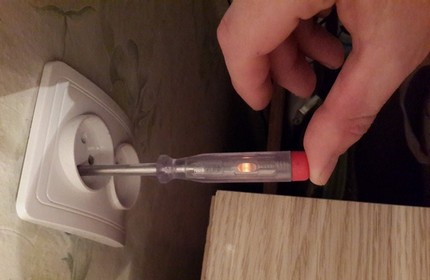
But when working with wiring equipped with a grounding wire, it is still better use a multimeter. This multifunctional device, even if of the simplest design, will become an indispensable assistant even when detecting a wire break, determining the integrity of radio and electrical components.
Using the device is not difficult. On a multimeter set the range of measurements of alternating current to a mark of over 220 volts. Then one tentacle is applied to the phase contact, and the second to the "ground" or "0". Upon contact with "0", the voltage 220V will be reflected on the device, on the "ground" the voltage will show slightly lower.
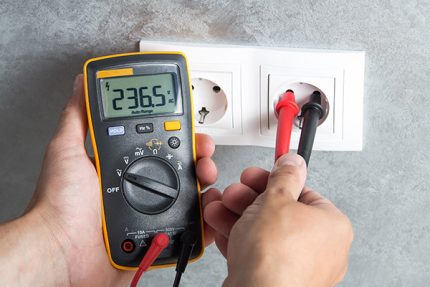
If there is no indicator screwdriver or multimeter available, the conventional marking will help determine the accessory of the wires.
In order to create a safe environment when performing electrical work and to facilitate the process of connecting contacts, it is a rule that each core of the wire has a characteristic color of insulation.

According to the current PUE in a three-phase electrical network, the insulation of the wires is distinguished by the colors:
- zero working contact "N" has a blue or blue braid;
- phase "L" most often has a bright color (brown, black, white, orange);
- grounding "RE" painted in a yellow-green tint.
When dealing with non-standard marking, it will be a little more difficult to determine the “phase”, but the color “0” will not change in any case.
Device Connection Diagram
The main core laid from the shield to the cable outlet is stripped to a height of 7-8 cm from the edge. The ends of the wires placed inside it are cleaned with a knife from the braid to a height of 10-12 mm from the edge.
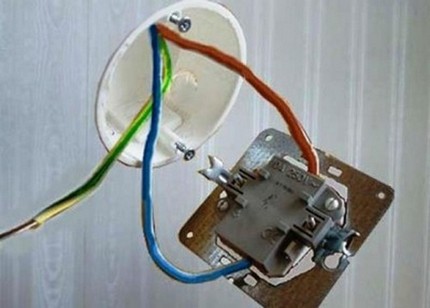
The work should be carried out as carefully as possible, since the slightest damage to the insulation of the neutral core can provoke the closure of the "phase" on the device body. As a result, when the neutral wire is broken, the electrical devices connected to the point do not work, and the outlet looks dead and seems at first glance safe.
The protective wire is connected to additional contacts located separately from the power ones. The zero and phase wires lead to the power contacts. The sequence of their installation does not play a significant role.

When connecting all three conductors, it is important to ensure high reliability of the contacts. This is because weak contact can cause an increase in current, as a result - heating of the cables. The occurrence of such a situation can lead to an emergency.
Checking the connection
Verify the quality of grounding allows verification. It is performed using the same multimeter or a tester screwdriver.The end of the tester is alternately immersed in the openings of the outlet and observed: when you touch the "phase", it should light up.
If the tester reacts when it touches the “ground”, this indicates an incorrect connection of the outlet.
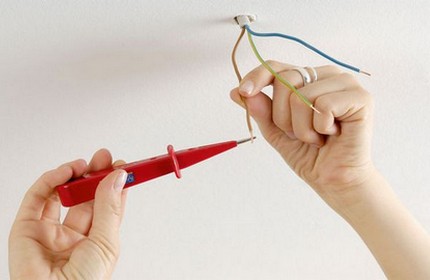
Lack of voltage may indicate:
- between "phase" and "N" indicates the presence of a cliff of the latter;
- between the "ground" and the "phase" indicates a lack of tension;
- between "ground" and "N" indicates that the wires are merged through the jumper installed in the outlet.
Performing grounding test using a multimeter, one probe is applied to the "ground" - the top or center of the outlet. In parallel with this, the second probe is alternately immersed in the holes.
If you find the wrong ground, do not rush to correct the error yourself. It is best to consult a qualified electrician.
Grounding and grounding: what is the difference
One of the common installation errors is when connecting the outlet to ground is performed by activating the “0” two-wire network. This method in the language of electricians is called as "grounding". In its implementation, “0” is used as a protective and zero working contact.
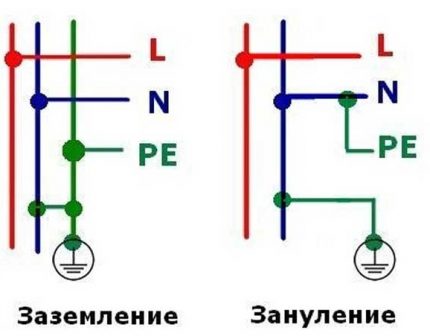
But grounding is not an equivalent alternative to grounding. After all, the line cannot protect itself from itself.
So, for example, in the event of “0” disappearing as a result of the same cable breakage on the input shield or unreasonable actions of an unskilled “craftsman” at the moment of switching on the device, the circuit closes. But at the same time, on the neutral wire, which is essentially not connected to the ground, such voltage arises as on the phase.
As a result: an electrical installation, grounded by means of grounding and turned out to be energized, transfers it to a person. The most favorable outcome in this situation is if a short circuit occurs that provokes a “knocking out of the machine”. Otherwise, the price of such a zeroing can become deplorable.
It is worth taking into account the fact that, according to the installation technology of the in-house electrical wiring, at the input, packet bags or two-pole machines are installed that switch both “phases” and “0”.
According to accepted standards, it is forbidden to use the neutral conductor as a protective conductor in a circuit where there is a switching device.
Conclusions and useful video on the topic
Connection Guide:
How to ground for a wall outlet:
Where to get grounding in the floor shield:
Knowing how to make grounding in a power outlet, you can increase the safety of the electrical system in your home and minimize the chance of accidents.
If you have experience in connecting ground outlets, please share this information with our readers. Leave comments on the publication and ask questions on the topic in the form below.

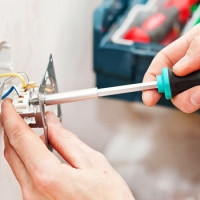 How to install and connect an outlet: a step-by-step guide
How to install and connect an outlet: a step-by-step guide 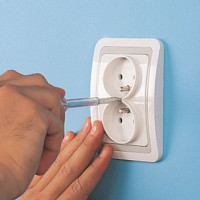 How to connect a double outlet: installing a double outlet in one socket
How to connect a double outlet: installing a double outlet in one socket 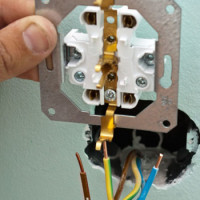 How to make two from one outlet and how to properly conduct an outlet from an outlet
How to make two from one outlet and how to properly conduct an outlet from an outlet  How to connect a telephone socket: connection diagram and installation rules
How to connect a telephone socket: connection diagram and installation rules 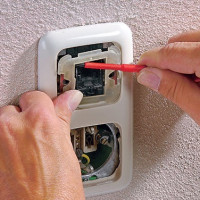 A socket with a switch in one housing: how to connect a socket with a switch
A socket with a switch in one housing: how to connect a socket with a switch  How to connect an Internet outlet: a step-by-step installation guide
How to connect an Internet outlet: a step-by-step installation guide  How much does it cost to connect gas to a private house: the price of organizing gas supply
How much does it cost to connect gas to a private house: the price of organizing gas supply  The best washing machines with dryer: model rating and customer tips
The best washing machines with dryer: model rating and customer tips  What is the color temperature of light and the nuances of choosing the temperature of the lamps to suit your needs
What is the color temperature of light and the nuances of choosing the temperature of the lamps to suit your needs  Replacement of a geyser in an apartment: replacement paperwork + basic norms and requirements
Replacement of a geyser in an apartment: replacement paperwork + basic norms and requirements
In general, here it is necessary to start with the recommendations to change the wiring in the apartments of the old buildings, where there was still no talk about grounding. Indeed, our modern devices must be grounded, and not nullified.At the very least, this allows you to use the equipment much more comfortably. Also surprising are those who insistently put simple sockets on a three-wire wiring, ignoring grounding.
Good afternoon. Being determines consciousness, Igor - remember this philosophical conclusion? The desire to modernize the wiring will be realized with an abundance that repeatedly covers the size of the subsistence level.
Those who want to “resist” economic circumstances can live with a two-wire system (with zeroing) and cost a diverse arsenal of RCD outlets. I attached a screenshot with an example of the cost of alterations - check out the price tag.
When replacing the wiring in his apartment, I ran into the problem of grounding. The house is old, there was no ground loop. Electricians offered grounding as an alternative. This approach did not suit me. He made the grounding system himself. Along the guards of the entrance, he laid a copper bus with a conclusion to the street. The bus was grounded to armature driven into the ground (driven to a depth of 2.5 meters). Additionally installed an RCD for more reliable protection against damage to equipment and devices when the load is exceeded.
I have a similar problem, but no solution yet. He looked into the shield at the entrance, and there the zero wire is screwed to the shield body. Pulling yourself from the 8th floor is not an option.
Good day, Sergey. The absence of visible elements of the system grounding does not always mean its absence. The grounding role can be performed, for example, by the sheath and armor of the cable, through which the power supply of your 8-story building is provided. And the floorboards themselves are connected by pipe wiring?
In any case, the management company should be concerned about the problem - it is advisable to sign the “petition” with the tenants. Grounding system - a common house device. While there is no grounding, you can get by with RCD outlet sockets. Read the articles in the section "RCDs and machines".